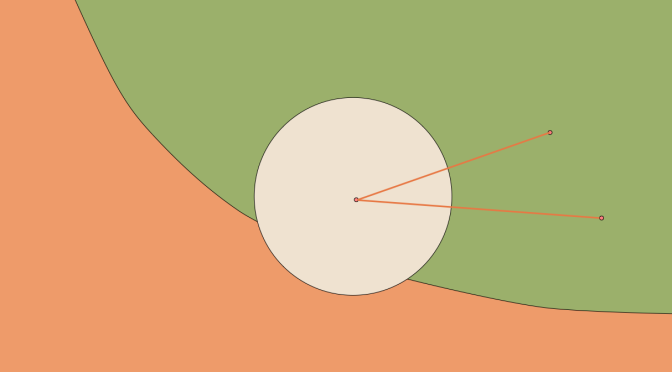We consider a normed vector space \(E\) over the field of the reals \(\mathbb{R}\) and a convex subset \(C \subset E\).
We suppose that \(0 \in C\) and that \(C\) is unbounded, i.e. there exists points in \(C\) at distance as big as we wish from \(0\).
The following question arises: “does \(C\) contains a ray?”. It turns out that the answer depends on the dimension of the space \(E\). If \(E\) is of finite dimension, then \(C\) always contains a ray, while if \(E\) is of infinite dimension \(C\) may not contain a ray.
Finite-dimensional case
Even if it means reducing the dimension of the space, we can suppose that \(0\) is an interior point of \(C\). By hypothesis, there exists a sequence \((y_n)_{n \in \mathbb{N}}\) with \(y_n \in C\) and \(\Vert y_n \Vert > n \) for all \(n \in \mathbb{N}\). The sequence \((\frac{y_n}{\Vert y_n \Vert})_{n \in \mathbb{N}}\) belongs to the unit sphere which is compact as \(E\) is supposed finite-dimensional. Therefore it has a converging subsequence (this is the Bolzano-Weierstrass theorem). By renumbering the sequence \((y_n)_{n \in \mathbb{N}}\), we can even suppose that \((\frac{y_n}{\Vert y_n \Vert})_{n \in \mathbb{N}}\) itself converge to a vector \(v\).
Let’s prove that \(C\) contains points as far as we want from \(0\) on the line \(\mathbb{R} v\). We pick-up a real \(A > 0\). There exists \(N \in \mathbb{N}\) such that \(\Vert y_n \Vert \ge A\) for all \(n \ge N\). As \(0 \in C\) and \(C\) is supposed convex, the points \(w_n = A \frac{y_n}{\Vert y_n \Vert}\) belongs to \(C\) for \(n \ge N\). Moreover the sequence \((w_n)_{n \in \mathbb{N}}\) converges to \(A v\). As \(0\) is supposed to be an interior point of \(C\), \(w_n – Av \in C\) for \(n\) big enough. Then also:
\[\frac{1}{2}A v= \frac{1}{2}(w_n+(A v -w_n)) \in C\] Finally, the ray \([0,+\infty v)\) belongs to \(C\).
A counter-example in the infinite-dimensional case
Let’s take a sequence \(\textbf{e}=(e_n)_{n \in \mathbb{N}}\) of linearly independent vectors whose sequence of norms converges to \(+ \infty\) and for \(C\) the convex hull of that sequence. If \(C\) contains a ray, it also contains two points \(a\) and \(b\) that are convex combinations of vectors of the sequence \(\textbf{e}\). Therefore, \(a\) and \(b\) belongs to a finite-dimensional space \(F=\mathbb{R}e_1 + \cdots + \mathbb{R}e_N\) as well as the ray that is supposed to be contained in \(C\). But \(C \cap F\), which is the convex hull of \(\{e_1, \dots, e_n\}\) is compact (see here), a contradiction.

